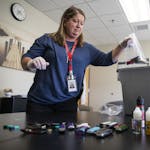At 21, Duluth bookkeeper Henry Carlson got a crazy idea 100 years ago. He saved up about $300 to buy a Harley-Davidson motorcycle, complete with a sidecar and a V-twin engine that engineer Bill Harley had first designed 10 years earlier.
In September of 1919, Carlson and co-worker Harvey MacFarlane quit their staid accounting jobs at Standard Oil Co. and headed west on a 1,400-mile odyssey across the unpaved plains of North Dakota and the mountains of Montana. The roads were awful, the bike broke down often but they had a blast with the 6-foot-3 MacFarlane squeezed into the sidecar and Carlson straddling the roaring V-twin.
"Henry is some pilot and I just sit and look on (when I am not two or three feet in the air) of course," MacFarlane wrote in a postcard from the Aitkin Hotel after Day 1 to Carlson's girlfriend, 18-year-old Louise Nelson, back in Duluth.
Before embarking, Henry had taken some test runs from Duluth to his hometown of South Range, Wis., 15 miles to the south — with Louise in his sidecar. "I am not as enjoyable ballast as he had on those trips to South Range," MacFarlane quipped in his postcard.
Wearing tightfitting breeches known as jodhpurs tucked in high boots, Carlson and his buddy visited Yellowstone National Park and made it to Spokane, Wash., where they landed jobs at the Great Northern Railroad for a while before returning to Duluth.
Three years after the long ride, Henry sold his Harley to pay for an engagement ring. He and Louise were married 61 years, raised two kids and launched a long successful career in the Duluth grain milling business.
"I'm bitten with regret that none of us seem to have asked Grandpa more about the trip before he died" in 1983, said Kathryn Oakley, 72, Carlson's granddaughter in St. Paul. "The 1919 trip was probably the most adventurous thing he did in his very responsible, hardworking life."
Carlson's hearing loss in later years inhibited the storytelling, but he loved to repeat the tale of hocking the Harley for an engagement ring, according to his 91-year-old sole surviving child, Dick Carlson.
Luckily for Oakley and other descendants, Louise kept a book with 15 blurry black-and-white photographs from the 1919 trek — along with postcards and telegrams. Some of the images show bleak dirt roads, others include Carlson and MacFarlane with the Harley loaded down with their bedrolls, duffel bags and kitchen supplies.
Sifting through the stories and pictures, Oakley devised a theory about what might have inspired her grandfather to trade in his desk job for the bumpy open road.
In the summer of 1919, just before Carlson's epic ride, the U.S. Army embarked on the first transcontinental motor convoy — sending 81 trucks, cars and motorcycles cross-country from Washington D.C. to San Francisco. The New York Times called it "the largest aggregation of motor vehicles ever started on a trip of such length."
It took two months to cover the 3,251 miles and test wartime military mobility along what was then known as the Lincoln Highway and is now Interstate Hwy. 80.
Among the drivers was a 28-year-old Army officer, Lt. Col. Dwight Eisenhower.
"In Nebraska, the first real sand was encountered," the future World War II hero and 34th U.S. president wrote of his journey.
"From Orr's Ranch, Utah, to Carson City, Nevada, the road is one succession of dust, ruts, pits and holes."
Ike marveled at the German autobahn network as he led the U.S. military against the Nazis in World War II. Along with that 1919 trip, he grew convinced that the United States needed to construct an interstate highway system — one of his signature initiatives during his two presidential terms in the 1950s.
We don't know for sure if that's what sparked Henry Carlson and Harvey MacFarlane to make their own trip a month later. Carlson's granddaughter used the distances between towns mentioned in the postcards to estimate the pair averaged about 30 mph and 250 miles a day — taking about 10 days to make it to Spokane.
"All these years later," Oakley said, "it's hard to know whether Spokane was their ultimate goal or whether they were just tired of bouncing along the road."
A roll of adding machine paper, with notes from 20 co-workers back in Duluth, is among the artifacts her grandmother saved. One note on the paper mentioned Mildred Coleman, MacFarlane's girlfriend, who was doing "fine but sure she is lonesome."
A photo in her grandmother's album shows Mildred and Louise in the wide-brimmed, feathered hats of the era — looking somewhat forlorn.
Like Henry and Louise, Mildred and Harvey wed not long after the motorcycle journey west. He enjoyed a long career in the insurance business in Green Bay, Wis.
"The two couples met at least yearly in Duluth or Green Bay to renew their long friendship," Oakley said, "and to reminisce about that motorcycle trip out west in 1919."
Curt Brown's tales about Minnesota's history appear each Sunday. Readers can send him ideas and suggestions at mnhistory@startribune.com.


![Kathy Cargill's home in Duluth's Park Point neighborhood. Cargill's limited liability company has purchased more than 20 parcels on the point. ] JANA](https://arc.stimg.co/startribunemedia/BTNQVSCQD5GQLP6YRUSBSH6FQM.jpg?w=75&h=75&fit=crop&crop=faces)



